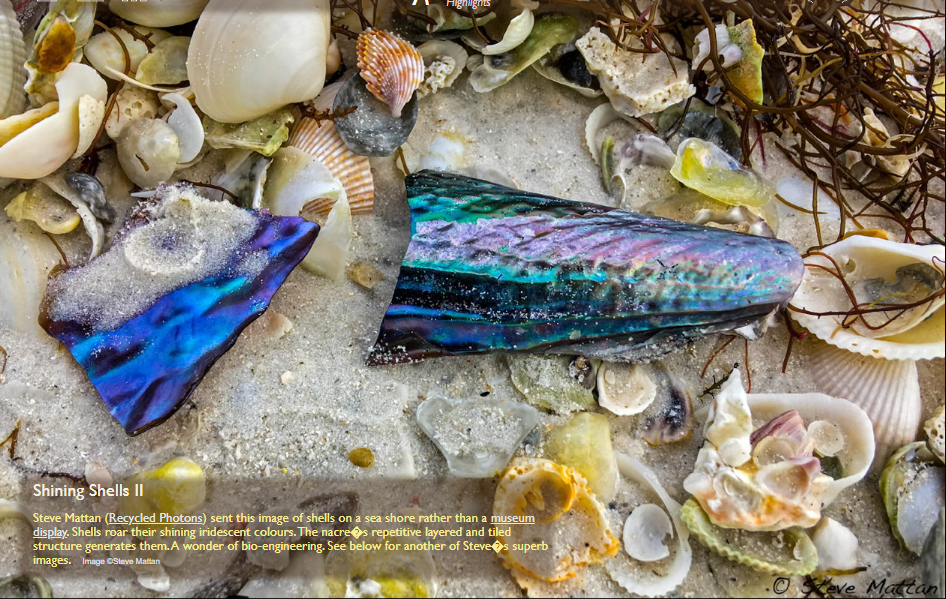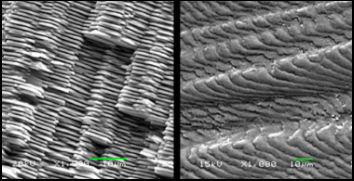Shining Mollusc Shells II
Shining Mollusc Shells II: Unveiling the Wonders of Iridescent Colors
When strolling along a sea shore, you may come across a mesmerizing sight: shells that gleam with iridescent colors, captivating the eyes with their shimmering beauty. These vibrant hues are not mere pigments but are generated by the unique structure of the shells' nacre, also known as mother-of-pearl. In this article, we will delve deeper into the fascinating world of mollusc shells and explore the science behind their radiant appearance.
The colors observed on the surface of nacre are primarily a result of its microscopic ridges, which act as a natural diffraction grating. This intricate structure is composed of polygonal tiles made from a remarkably hard crystalline form of calcium carbonate called aragonite. Each tile is a single crystal, measuring about 10 microns across. The tiles are held together by a matrix of conchiolin, polysaccharide, and protein fibers, forming stacked layers that create a strong and resilient structure.
It is the edges of these stacked layers that give rise to the surface ridges responsible for the iridescent colors. This discovery was first made in the 19th century by David Brewster, a scientist from Edinburgh University, who created a wax cast of a shell surface. To his surprise, even the wax cast exhibited iridescent colors, confirming that the ridges were indeed the source of this optical phenomenon.
The regularity of the tile structure in nacre is truly remarkable and owes its precision to the control exerted by protein secretions during its formation. Initially, aragonite crystals nucleate randomly on a thin protein layer. Ordinarily, crystal growth would occur perpendicular to this layer, along the "c" axis. However, proteins selectively absorb onto the top crystal faces, preventing growth in this direction. As a result, horizontal growth takes place, and contact with adjacent tiles eventually leads to a regular spacing between them.
To maintain the desired thickness of the tiles, periodic injections of an inhibitor protein are hypothesized. This process limits the tile thickness to approximately 0.5 microns. Once this thickness is reached, an upper terrace of crystal begins to form on the face of each tile and gradually grows into a second layer. This cycle repeats, layer upon layer, until the nacre achieves its characteristic strength and iridescence.
The remarkable optical properties of nacre go beyond its surface structure. When light enters the nacre, it undergoes a phenomenon known as multilayer interference. Some light penetrates into the layers, interacting with the different interfaces and reinforcing specific wavelengths. This interplay between diffraction and interference contributes to the vibrant display of colors observed on the shell's surface.
It is important to note that the iridescent colors exhibited by mollusc shells are not due to pigments but are purely optical effects resulting from the structure of nacre. Unlike pigments that absorb certain wavelengths of light and reflect others, the colors observed on these shells are a result of light interacting with the microstructure and interfering constructively or destructively, depending on the path length differences within the layers.
The intricate beauty of shining mollusc shells serves as a testament to the wonders of bio-engineering. The precise control exerted by proteins during the formation of nacre showcases nature's ability to create complex and visually stunning structures. By unraveling the secrets behind these shimmering shells, scientists gain insights that could inspire advancements in materials science and optical engineering.
In conclusion, the iridescent colors seen on mollusc shells are a result of their nacre's unique structure. The microscopic ridges act as a diffraction grating, while the stacked layers of aragonite tiles create a mesmerizing display of colors through multilayer interference. The precise control exerted by proteins during the formation of nacre ensures the regularity and strength of the shell structure. As we continue to explore and appreciate the marvels of atmospheric optics, the shining mollusc shells stand as a testament to the captivating beauty that can be found in the natural world.

Shining Shells II
Steve Mattan (Recycled Photons) sent this image of shells on a sea shore rather than a museum display. Shells roar their shining iridescent colours. The nacre�s repetitive layered and tiled structure generates them. A wonder of bio-engineering. See below for another of Steve�s superb images. Image ©Steve Mattan
The colours come mainly from the nacre surface structure. It has uniform microscopic ridges - A naturally made diffraction grating. Some light penetrates into the nacre and that adds to the surface generated colour by multilayer interference.
Where come the ridges?
Nacre is made up of polygonal (usually hexagonal) tiles of a very hard crystalline form of calcium carbonate, aragonite. Each tile is a single crystal some 10 microns across. A thin matrix of conchiolin, polysaccharide and protein fibres, cements them together into tessellated stacked layers to form a very strong structure.
The edges of the layer stacks form the surface ridges. That the ridges produce the colours was first proved in the 19th Century by David Brewster of Edinburgh University. He made a wax cast of a shell surface. The wax cast also showed iridescent colours!

Stacked layers of aragonite tiles Regularly spaced surface grooves
The green bars represent 10 micron.
Images ©T L Tan, D Wong & P Lee, Iridescence of a shell of mollusk Haliotis Glabra, Optics Express, Vol. 12, Issue 20, pp. 4847-4854 (2004)
The tile structure�s regularity is remarkable. Protein secretions control its formation.
Initially there is random nucleation of aragonite on a thin protein layer. The fastest crystal growth would normally be perpendicular to the layer along the �c� axis but this is rather neatly prevented by the selective absorption of proteins onto the top crystal faces. Horizontal growth proceeds instead and contact with adjacent tiles eventually forces a regular spacing.
Periodic injections of an inhibitor protein is hypothesised to limit the tile thickness to 0.5 micron. An upper terrace of crystal then starts to form on the face of each tile and eventually grows into a second layer.
And so on.

Note: this article has been automatically converted from the old site and may not appear as intended. You can find the original article here.
Reference Atmospheric Optics
If you use any of the definitions, information, or data presented on Atmospheric Optics, please copy the link or reference below to properly credit us as the reference source. Thank you!
-
<a href="https://atoptics.co.uk/blog/shining-mollusc-shells-ii/">Shining Mollusc Shells II </a>
-
"Shining Mollusc Shells II ". Atmospheric Optics. Accessed on December 22, 2024. https://atoptics.co.uk/blog/shining-mollusc-shells-ii/.
-
"Shining Mollusc Shells II ". Atmospheric Optics, https://atoptics.co.uk/blog/shining-mollusc-shells-ii/. Accessed 22 December, 2024
-
Shining Mollusc Shells II . Atmospheric Optics. Retrieved from https://atoptics.co.uk/blog/shining-mollusc-shells-ii/.